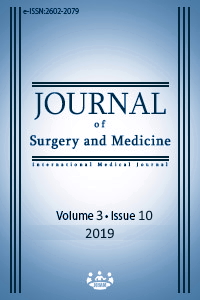The measurement of skin to epiglottis length for difficult airway prediction by ultrasonography in obese pregnant women: Prospective cohort study
Keywords:
: Obesity, Pregnancy, Difficult airway, UltrasonographyAbstract
Aim: The risk of difficult airway is high in obstetric anesthesia, and weight gain above physiological limits further increases this risk. Ultrasonography (USG) has often been used recently in airway evaluation of all patient groups. The aim of this study was to investigate the effect of weight gain beyond physiological limits on the measurement of the distance of the skin-to epiglottis (DSE) with USG.
Methods: 50 pregnant women aged between 20-40 years, half of which had gained weight within physiological limits during pregnancy (<15kg) (Group 1) and the other half whose weight gain was equal to or greater than 15 kilograms (Group 2) were included in this study. The measurements were labelled as “a” and “b” for the first and third trimesters. Mallampati evaluation was made during ultrasonographic measurements in all pregnant patients by an anesthesiologist blinded to the study.
Results: No statistically significant difference was determined between the Group 1 and Group 2 pregnant patients with respect to age, BMI, and distance of skin to epiglottis (DSE) values (P=0.293, P=0.281, P=0.515). A statistically significant increase in BMI and DSE was detected in Group 2b when compared to Group 1b (both: P<0.001).
Conclusion: Ultrasonographic DSE measurement in pregnant women with weight gain above the physiological limit during pregnancy may be used to predict difficult airways when utilized together with Mallampati scoring, especially during the third trimester.
Downloads
References
Girard T, Palanisamy A. The obstetric difficult airway: if we can't predict it, can we prevent it? Anaesthesia. 2017;72:143-7.
Mushambi MC, Kinsella SM, Popat M, Swales H, Ramaswamy KK, Winton AL et al. Obstetric Anaesthetists’ Association and Difficult Airway Society Guidelines for the management of difficult and failed tracheal intubation in obstetrics. Anaesthesia. 2015;70:1286-306.
Riveros-Perez E, McClendon J, Xiong J, Cheriyan T, Rocuts A. Anesthetic and obstetric outcomes in pregnantwomen undergoing cesarean delivery according to body mass index: Retrospective analysis of a single-center experience. Ann Med Surg. 2018;36:129-34.
Abe H, Sumitani M, Uchida K, Ikeda T, Matsui H, Fushimi K, et al. Association between mode of anaesthesia and severe maternal morbidity during admission for scheduled Caesarean delivery: a nationwide population-based study in Japan, 2010-2013. Br J Anaesth. 2018;120:779-89.
Patel S, Weierstahl KL, Shah S, Fidkowski CW. Anesthetic Management for Cesarean Delivery in a Patient With Pulmonary Emboli, Pulmonary Hypertension, and Right Ventricular Failure. A Case Rep. 2016;7:146-9.
Singh M, Chin KJ, Chan VW, Wong DT, Prasad GA, Yu E. Use of sonography for airway assessment: an observational study. J Ultrasound Med 2010;29:79–85.
Adhikari S, Zeger W, Schmier C, Crum T, Craven A, Frrokaj I, et al. Pilot study to determine the utility of point-of-care ultrasound in the assessment of difficult laryngoscopy. Acad Emerg Med 2011;18:754–8.
Gaiser R. Maternal and fetal physiology. In: Chestnut DH, Wong LC, Tsen LC, Ngan Kee WD, Beilin Y, Mhyre J, editors. Obstetric anesthesia: principles and practice. 5th ed. Philadelphia: Saunders; 2014. p. 15–38.
Pinto J, Cordeiro L, Pereira C, Gama R, Fernandes HL, Assunção J. Predicting difficult laryngoscopy using ultrasound measurement of distance from skin to epiglottis. J Crit Care. 2016;33:26-31.
Bulut B, Mihmanlı, V. Obesity and Pregnancy. Okmeydanı Med J. 2014;30: 24-8.
Hui CM, Tsui BC. Sublingual ultrasound as an assessment method for predicting difficult intubation: a pilot study. Anaesthesia. 2014;69:314–9.
Weiniger CF, Sharoni L.The use of ultrasound in obstetric anesthesia.Curr Opin Anaesthesiol. 2017;30:306-12.
Ezri T, Gewürtz G, Sessler DI ,Medalion B, Szmuk P, Hagberg C, et al. Prediction of difficult laryngoscopy in obese patients by ultrasound quantification of anterior neck soft tissue. Anaesthesia. 2003;58:1111-4.
D’Angelo R, Habib AS. Obesity. In: Chestnut DH, ed. Obstetric anesthesia: principles and practice, 5th edn. Philadelphia: Elsevier Mosby, 2014:1141–56.
Boutonnet M,Faitot v, Katz A, Salomon L, Keita H. Mallampati class changes during pregnancy,labour, and after delivery: can these be predicted? Br J Anaesth. 2010;104:67-70.
Pilkington S, Carli F, Dakin MJ, Romney M, De Witt KA, Doré CJ, et al. Increase in Mallampati score during pregnancy. Br J Anaesth. 1995;74:638–42.
Downloads
- 1177 1743
Published
Issue
Section
How to Cite
License
Copyright (c) 2019 Çiğdem Ünal Kantekin, Mustafa Fatih Erkoç, Gamze Talih
This work is licensed under a Creative Commons Attribution-NonCommercial-NoDerivatives 4.0 International License.
















